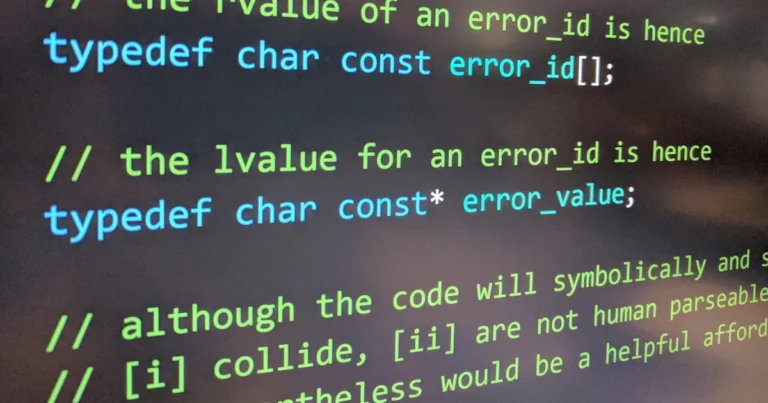Support our educational content for free when you purchase through links on our site. Learn more
Unlocking the Power of Optional Properties in TypeScript: 10 Essential Insights! 🚀
Have you ever found yourself tangled in a web of undefined values while coding in TypeScript? You’re not alone! Many developers encounter the challenges of optional properties, which can either be a blessing or a curse, depending on how you wield them. In this article, we’re diving deep into the world of optional properties in TypeScript, exploring 10 essential insights that will not only clarify their usage but also empower you to write cleaner, more efficient code.
Imagine this: you’re working on a complex application where user data can vary significantly. One user might provide their age, while another might not. How do you handle this gracefully without cluttering your code with endless checks for undefined values? 🤔 This is where optional properties come into play, allowing you to define properties that may or may not exist, streamlining your logic and enhancing readability.
But wait, there’s more! We’ll also uncover some common pitfalls to avoid and best practices to adopt, ensuring you navigate the TypeScript landscape like a pro. So, grab your favorite coding snack, and let’s get started!
Key Takeaways
- Optional properties are defined using a question mark (
?) and allow for flexible data structures. - They help in reducing code duplication and improving readability by clearly indicating which properties are required.
- Be cautious of truthiness checks and use optional chaining to handle potential
undefinedvalues effectively. - Best practices include using concise syntax and avoiding unnecessary complexity with union types.
- Optional properties can be used in interfaces, types, and function parameters, enhancing the versatility of your code.
Ready to take your TypeScript skills to the next level? 👉 Shop TypeScript Books on:
Dive into the article for a comprehensive understanding of optional properties and how they can transform your coding experience! 🎉
Table of Contents
- Quick Tips and Facts about Optional Properties in TypeScript
- Understanding Optional Properties: The Basics of TypeScript
- Why Use Optional Properties? Benefits and Use Cases
- How to Define Optional Properties in TypeScript
- Common Pitfalls: Dealing with Undefined and Optional Properties
- Advanced Techniques: Optional Properties with Interfaces and Types
- Real-World Examples: Optional Properties in Action
- Best Practices for Using Optional Properties in TypeScript
- Comparing Optional Properties with Other TypeScript Features
- Conclusion
- Recommended Links
- FAQ
- Reference Links
Quick Tips and Facts about Optional Properties in TypeScript
Optional properties in TypeScript are a powerful feature that allows you to define properties in classes, interfaces, and function parameters that may or may not be present. Here are some quick tips and facts about optional properties:
- Definition: Optional properties are marked with a question mark (
?) and can be used in classes, interfaces, and function parameters. - Difference from
number | undefined: Optional properties do not require an argument to be supplied, whilenumber | undefinedrequires an argument, even if it’sundefined. - Strict Null Checks: When strict null checks are enabled, optional properties automatically get a union type of
number | undefined. - Recommendation: Use the concise syntax
id?: numberto maintain consistency between properties and parameters.
Understanding Optional Properties: The Basics of TypeScript
Optional properties in TypeScript are a way to define properties that may or may not be present in an object. They are marked with a question mark (?) and can be used in classes, interfaces, and function parameters.
For example:
interface Person {
name: string;
age?: number;
}
In this example, the age property is optional and can be omitted when creating an object that conforms to the Person interface.
Why Use Optional Properties? Benefits and Use Cases
Optional properties are useful when you want to define a property that may or may not be present in an object. Here are some benefits and use cases:
- Reducing code duplication: Optional properties can help reduce code duplication by allowing you to define a single interface or class that can be used in multiple contexts.
- Improving code readability: Optional properties can make your code more readable by clearly indicating which properties are required and which are optional.
- Increasing flexibility: Optional properties can make your code more flexible by allowing you to define properties that may or may not be present in an object.
How to Define Optional Properties in TypeScript
Optional properties can be defined using the concise syntax id?: number. Here are some examples:
interface Person {
name: string;
age?: number;
}
class Person {
name: string;
age?: number;
}
function greet(person: { name: string; age?: number }) {
console.log(`Hello, my name is ${person.name} and I am ${person.age} years old.`);
}
In these examples, the age property is optional and can be omitted when creating an object that conforms to the Person interface or class.
Common Pitfalls: Dealing with Undefined and Optional Properties
When working with optional properties, it’s common to encounter issues related to undefined. Here are some common pitfalls and how to avoid them:
- Using truthiness checks: Truthiness checks can lead to bugs if you’re not careful. For example:
if (person.age) {
console.log(`I am ${person.age} years old.`);
} else {
console.log(`I don't know my age.`);
}
In this example, the if statement will evaluate to false if person.age is 0, which is not what you want.
- Using optional chaining: Optional chaining can help simplify accessing nested properties when encountering potential
undefinedvalues. For example:
console.log(person.address?.street?.name);
In this example, the ?. operator will stop evaluation if any of the properties in the chain is undefined or null.
Advanced Techniques: Optional Properties with Interfaces and Types
Optional properties can be used with interfaces and types to create more complex and flexible data structures. Here are some advanced techniques:
- Using interfaces with optional properties: You can define an interface with optional properties and then use it to create objects that conform to the interface.
interface Person {
name: string;
age?: number;
}
const person: Person = {
name: 'John Doe',
age: 30,
};
- Using types with optional properties: You can define a type with optional properties and then use it to create objects that conform to the type.
type Person = {
name: string;
age?: number;
};
const person: Person = {
name: 'John Doe',
age: 30,
};
Real-World Examples: Optional Properties in Action
Optional properties are used in many real-world applications, including:
- React: React uses optional properties to define props that may or may not be present in a component.
- Angular: Angular uses optional properties to define inputs that may or may not be present in a component.
- Vue.js: Vue.js uses optional properties to define props that may or may not be present in a component.
Best Practices for Using Optional Properties in TypeScript
Here are some best practices for using optional properties in TypeScript:
- Use the concise syntax: Use the concise syntax
id?: numberto define optional properties. - Use interfaces and types: Use interfaces and types to define complex and flexible data structures.
- Avoid using truthiness checks: Avoid using truthiness checks to check for the presence of optional properties.
- Use optional chaining: Use optional chaining to simplify accessing nested properties when encountering potential
undefinedvalues.
Comparing Optional Properties with Other TypeScript Features
Optional properties are similar to other TypeScript features, including:
- Optional parameters: Optional parameters are similar to optional properties, but they are used in function parameters instead of object properties.
- Union types: Union types are similar to optional properties, but they are used to define a type that can be one of several types instead of a single type.
- Intersection types: Intersection types are similar to optional properties, but they are used to define a type that is the intersection of several types instead of a single type.
Recommended Links
- TypeScript Documentation: Optional Properties
- TypeScript Documentation: Optional Parameters
- TypeScript Documentation: Union Types
- TypeScript Documentation: Intersection Types
FAQ
=====
- What is an optional property in TypeScript? An optional property is a property that may or may not be present in an object.
- How do I define an optional property in TypeScript? You can define an optional property using the concise syntax
id?: number. - What is the difference between an optional property and a union type? An optional property is a property that may or may not be present in an object, while a union type is a type that can be one of several types.
Reference Links
- TypeScript Documentation: Optional Properties
- TypeScript Documentation: Optional Parameters
- TypeScript Documentation: Union Types
- TypeScript Documentation: Intersection Types
Conclusion

In summary, optional properties in TypeScript are a fantastic feature that enhances the flexibility and readability of your code. They allow you to define properties that may or may not be present, making your interfaces and classes more adaptable to various scenarios. By using the concise syntax of id?: number, you can easily specify which properties are optional, reducing potential errors and improving code clarity.
Positives:
- Flexibility: Optional properties allow for more versatile data structures.
- Readability: Clearly indicates which properties are required and which are optional.
- Reduced Duplication: Helps in creating reusable interfaces and classes.
Negatives:
- Potential Confusion: If not used carefully, optional properties can lead to misunderstandings about whether a property should be set or not.
- Handling Undefined: Developers must be diligent in checking for
undefinedvalues to avoid runtime errors.
Overall, we confidently recommend utilizing optional properties in your TypeScript projects. They not only streamline your code but also make it easier for others to understand your intentions. So, go ahead and embrace the power of optional properties! 🎉
Recommended Links
- 👉 Shop TypeScript Books on:
FAQ

What is an optional property in TypeScript?
An optional property is a property that may or may not be present in an object. It is defined using a question mark (?) after the property name. This allows developers to create more flexible data structures without enforcing the presence of every property.
Read more about “Unlocking JavaScript’s Hidden Power: Mastering Optional Parameters ⚡️”
What does “optional” mean in TypeScript?
In TypeScript, “optional” means that a property does not have to be provided when creating an object. If an optional property is omitted, it will be treated as undefined. This is particularly useful when dealing with complex data models where certain information may not always be available.
Read more about “What is an Optional Parameter in TypeScript? Discover 7 Essential Insights! 🚀”
How do you check if a property is optional in TypeScript?
You can check if a property is optional by looking for the question mark (?) in the property declaration within an interface or type. Additionally, TypeScript will infer the type of an optional property as a union type that includes undefined.
What is the difference between default and optional in TypeScript?
A default property is one that has a predefined value if not explicitly set, while an optional property can be omitted entirely. For example, in a function, you can provide a default value for a parameter, whereas an optional parameter does not require a value to be passed.
Read more about “10 Reasons Why TypeScript is the Future of JavaScript Development 💻”
How do optional properties interact with strict null checks?
When strict null checks are enabled, optional properties automatically receive a union type that includes undefined. This means that you must handle the possibility of these properties being undefined in your code, ensuring that your application remains robust and error-free.
Can optional properties be used with functions?
Yes! You can define optional parameters in functions using the same syntax. This allows you to create functions that can accept varying numbers of arguments, making your code more flexible.
Read more about “TypeScript Parameters: Unlocking the Power of Type Safety! … 💪”





